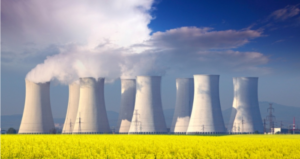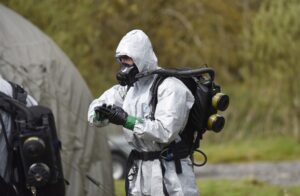
On July 25, at the office of the State Nuclear Regulatory Inspectorate of Ukraine (SNRIU), DIARU), the official transfer of permits to JSC NAEK Energoatom for the performance of organizational and administrative functions related to ensuring the nuclear and radiation safety of Ukrainian nuclear power plants, as well as the Centralized Spent Fuel Storage Facility (CSFSF), took place.
“This stage is part of the company’s reorganization – changing its form of governance from a state-owned enterprise to a joint-stock company,” the company said on Friday.
The licenses were handed over to Energoatom’s head, Petro Kotin, by the head of the State Nuclear Regulatory Inspectorate, Chief State Inspector for Nuclear and Radiation Safety, Oleg Korykov.
He noted that the SNRIU team had conducted inspections of all nuclear facilities and nuclear power plant sites and had given a positive assessment of Energoatom’s ability to comply with safety requirements, standards, and regulations, as well as the terms of the licenses.
“Obtaining licenses to operate under the new status confirms that Energoatom retains its full powers and ensures the continuous operation of nuclear power units,” emphasized the head of Energoatom.
The changes to the licenses were made in line with the law “On the Joint Stock Company National Nuclear Energy Generating Company Energoatom” and the Cabinet of Ministers’ resolution No. 1420 of December 29, 2023. “On the establishment of the joint-stock company ”National Nuclear Energy Generating Company “Energoatom.”
Currently, Energoatom operates nine power units at the South Ukraine, Rivne, and Khmelnytskyi NPPs with a total capacity of 7,880 MW. All of them are located in territory controlled by Ukraine.
The Zaporizhzhia Nuclear Power Plant, with six VVER-1000 power units with a total capacity of 6,000 MW, has not been producing electricity since September 11, 2022, following its occupation on March 3-4, 2022.

Ukraine will receive €22.6 million from European partners to ensure nuclear safety, improve radiation protection, and manage radioactive waste, according to the Ministry of Environmental Protection and Natural Resources.
The relevant draft agreement on the 2024/2025 contribution was approved during a meeting of the Supervisory Board for the Implementation of the Instrument for Nuclear Safety Cooperation in Ukraine. The meeting was held on Friday by Minister Svitlana Grynychuk together with Jan Pane, Director for Nuclear Energy, Safety and ITER at the European Commission’s Directorate-General for Energy, and Inte Stockmann, Head of the Nuclear Safety Sector at the European Commission’s DG INTPE.
The agreed contribution agreement provides for the financing of a number of projects that are important for Ukraine. These include: ensuring backup power supply for the uninterrupted operation of radioactive waste management facilities, as well as the construction of the necessary infrastructure for the proper disposal of radioactive waste; the creation of an early warning system for forest fires in the exclusion zone; equipping a modern analytical laboratory for the analysis of radioactive materials in Chernobyl; restoring the functioning of the automated radiation monitoring system in the exclusion zone damaged by Russia during the occupation of the Chernobyl NPP.
In addition, there are plans to create a national integrated automated radiation monitoring system for the entire territory of Ukraine and integrate it with the European Radiological Data Exchange Platform (EURDEP), the European Community Urgent Radiological Information Exchange System (ECURIE), the International Radiation Monitoring Information System (IRMIS) managed by the IAEA; providing personnel of enterprises in the exclusion zone with adequate modern transportation and accommodation in the exclusion zone, as well as personal protective equipment and decontamination facilities in emergency situations.
Attention will also be paid to harmonizing Ukrainian legislation with Euratom standards as one of the conditions for Ukraine’s accession to the EU.
All measures are planned to be implemented over a period of five years.